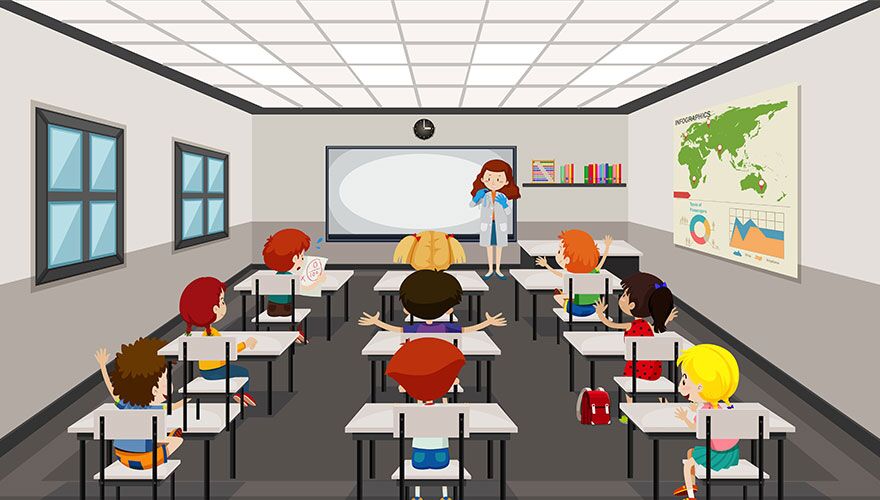
Student-teacher Ratio: Does this Make a Difference to Education Quality?
Several factors influence the quality of your child’s education, and one of the most significant is the student-teacher ratio. While this factor is critical, it is often overlooked.
Imagine sending your child to a school where the classrooms are filled with a sea of children, and the teacher has to creatively maneuver between closely stacked desks to move around the classroom. Since there is an abundance of students and limited class time, it becomes difficult for the teacher to focus on the weaknesses and strengths of each student genuinely. Even the curriculum cannot be tailored to suit each student’s needs.
On the other hand, if the classroom size is smaller, teachers can focus on teaching a handful of students. Students can be encouraged to use their unique voices and express their opinions without fear. They can remember their faces and names, along with their strengths, objectives, and academic challenges.
The difference between a low and a high student-teacher ratio in a CBSE school in Siliguri can significantly affect your child’s education quality. Typically, the right student-teacher ratio can hugely contribute to the success of a child’s academic life. Continue reading to know more.
Student-teacher Ratio: What Does it Mean?
The student-teacher ratio is the number of students for every teacher in a day or boarding school. The ratio reflects the workload of the teacher and how available they are to provide care and other services to their students. Generally, students and teachers agree that the lower the number of students for every teacher, the better the learning process and imparting education.
The Importance of the Right Student-teacher Ratio
One of the strongest student engagement and success indicators is the right student-teacher ratio. If teachers work with fewer students, they can work with them closely and adapt their teaching according to individualized needs. Healthy one-on-one relationships are also built, which is impossible if the classroom is filled with many students. Furthermore, a lower ratio will help lighten the workload for teachers and allow them to focus on imparting quality education instead of quantity education.
There are several reasons why a lower student-teacher ratio helps. Some of the reasons are explained below.
- Teachers Can Focus More on Individual Students if the Ratio is Lower
Learners require a high level of concentration and attention to comprehend the lessons fully. With a lack of attention, students will fail to grasp the subject taught in class.
When the classroom is overpopulated, the students might lose focus because they will be too busy chatting with their friends or trying to eavesdrop on a classmate’s conversation. Also, the teachers might miss students who aren’t paying attention because the classroom has too many students. Therefore, teachers can also become inattentive in such situations.
If the student-teacher ratio is low, it will help students get individual attention from the teacher and properly follow the activity board. It will also help them to remain attentive throughout the class. Since teachers can quickly pinpoint the students creating a ruckus in the classroom when there are fewer students, the students will ensure to remain disciplined and on their best behavior.
- Students can be Provided with Personalized Attention, and Teachers can Concentrate on Helping Each Child
When fewer students are in the class, the teacher can concentrate on each child’s requirements. It is a known fact that no child is equal. Some students require more assistance and help than others during the learning process. If the classroom is crowded, the teacher will fail to locate the students struggling with the lessons being taught.
However, with fewer students per class, teachers can observe the students and quickly figure out their issues. Then, teachers can devise a tailored lesson plan to overcome their learning difficulties.
Each classroom has fewer students, which helps each child get personalized attention from the teachers. Thanks to a low student-teacher ratio, every child will get individual attention, which will help them learn and grasp the subject better. That’s one of the reasons why the best boarding school in Darjeeling harps on maintaining a low student-teacher ratio.
- Teachers Find it Easier to Monitor and Manage a Class with Fewer Students
Class management and vigil over every student can be challenging if the classroom is overpopulated. The number of students attending a class must not exceed the standard limit. If there are fewer pupils, the teacher can effectively monitor the class and take care of the students’ needs.
Teachers can smoothly complete their lesson plans and manage the class. Also, there will be less disturbance during the learning sessions. The incidence of students not paying attention is quite less when the classes are not filled to the brim.
- Interactions in the Classroom are Smoother When there are Fewer Pupils
Classes with higher student-teacher ratios don’t have smooth interactions because too many people try to communicate with each other. If the classes have fewer students, it is possible to have interactive sessions. These interaction sessions turn out to be quite productive and help students understand the lessons better. The quality of education is also enhanced, and the student-teacher relationship is improved.
The Bottom Line
In summation, a lower student-teacher ratio is ideal because it can impact the quality of education. A teacher can concentrate on each student’s needs when the classroom is not overpopulated. Personalized teaching plans can be created keeping in mind the unique learning challenges of the students. When all of these are combined, the education quality is significantly impacted, and students can grasp the subjects quicker. They can reach out to the teachers with their problems and get immediate help.
Therefore, you must look for CBSE day and boarding schools that offer a healthy student-teacher ratio for your child’s academic success.
